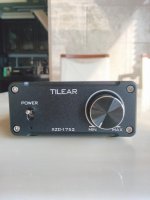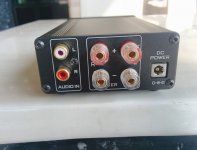If I understand what you've been saying correctly your set up doesn't use PE, if so, that reading doesn't mean anything.
My current setup uses PE. But, I tried it without PE.
With PE: voltage difference is close to 0 on the metal enclosure and the metal mute switch.
Without PE: voltage difference is 1.4~1.5 volts on the metal enclosure and 81 volts on the mute switch.
It seems I will benefit from PE anyway.
With PE: voltage difference is close to 0 on the metal enclosure and the metal mute switch.
Without PE: voltage difference is 1.4~1.5 volts on the metal enclosure and 81 volts on the mute switch.
It seems I will benefit from PE anyway.
Last edited:
Even if the power supply has class II insulation, the amp doesn't because voltage difference between PE and the amp's exposed bare metal parts is 81 volts.
Unless the amp also has class II insulation, PE is going to be important for safety.
I will either connect the amp to an earthed power supply or connect the amp's metal bolts to PE directly.
Unless the amp also has class II insulation, PE is going to be important for safety.
I will either connect the amp to an earthed power supply or connect the amp's metal bolts to PE directly.
Last edited:
Even if the power supply has class II insulation, the amp doesn't because voltage difference between PE and the amp's exposed bare metal parts is 81 volts.
Unless the amp also has class II insulation, PE is going to be important for safety.
I will either connect the amp to an earthed power supply or connect the amp's metal bolts to PE directly.
Before you do that, simply unplug the supply, turn the plug over 180 degrees and plug it back in.
It sounds to me like you have one or more miswired outlets in your home.
simply unplug the supply, turn the plug over 180 degrees and plug it back in. It sounds to me like you have one or more miswired outlets in your home.
Line and neutral were not reversed in every PE power cord according to my multimeter.
I aligned them all properly before with a multimeter.
I think it's ok for a non-PE power cord to reverse line and neutral.
Line and neutral were not reversed in every PE power cord according to my multimeter.
I aligned them all properly before with a multimeter.
I think it's ok for a non-PE power cord to reverse line and neutral.
Not the power cord ... your outlets.
Anyway, what is the best device to connect to PE? Computer monitor? Computer? Or, my amp?
For now, the most convenient way is to connect only my computer to PE. My monitor and my amp are connected to PE through my computer.
When everything is connected to PE through my computer, the voltage difference between PE and my amp's exposed metal parts is almost zero.
For now, the most convenient way is to connect only my computer to PE. My monitor and my amp are connected to PE through my computer.
When everything is connected to PE through my computer, the voltage difference between PE and my amp's exposed metal parts is almost zero.
Last edited:
@CowCat, voltage difference of such level (1,5V and a little bit more, under 50V) is safe.
Read again my post, maybe it will clarify your thoughts.
Do you have any kind of switching mode power supply in your amp (for stand by maybe)? If so, that is the reason why you have 80V difference.
First try what Douglas Blake wrote to you and if that didn't help, do what I suggested. If your socket is polarized (like UK and swiss socket), you can't do what he suggested.
Read again my post, maybe it will clarify your thoughts.
Do you have any kind of switching mode power supply in your amp (for stand by maybe)? If so, that is the reason why you have 80V difference.
First try what Douglas Blake wrote to you and if that didn't help, do what I suggested. If your socket is polarized (like UK and swiss socket), you can't do what he suggested.
As you can see from the pictures in the first page of the thread, the amp doesn't have an SMPS inside.
Just to clarify, when the amp is not connected to PE, the voltage difference between PE and the amp enclosure bolts is 81~82 volts, and that between PE and the amp enclosure is 1.4~1.5 volts.
Rotating the power plug of the amp power supply by 180 degrees doesn't change the voltage difference when the AMP is not connected to PE.
What should the voltage difference between PE and the amp enclosure be if the amp is not connected to PE?
Just to clarify, when the amp is not connected to PE, the voltage difference between PE and the amp enclosure bolts is 81~82 volts, and that between PE and the amp enclosure is 1.4~1.5 volts.
Rotating the power plug of the amp power supply by 180 degrees doesn't change the voltage difference when the AMP is not connected to PE.
What should the voltage difference between PE and the amp enclosure be if the amp is not connected to PE?
Last edited:
If there is no kind of connection then any readings are erroneous. What do you measure between enclosure bolts and enclose? Can you please show pictures of what you are doing?
There are four bolts on the front and four bolts on the back. When the amp is connected only to its power supply and nothing else, the AC voltage difference between PE and the bolts is 81~82 volts and that between PE and the black amp enclosure is 1.4~1.5 volts. When the amp is connected to its power supply and the computer, the AC voltage difference between PE and anything on the amp is almost zero because the computer is connected to PE.
I think the metal amp enclosure is anodized and has higher resistance than bolts do.
I think the metal amp enclosure is anodized and has higher resistance than bolts do.
Attachments
Yes, or painted. As pitbul said, static charge build up, nothing to worry about re longevity or safety
I think the metal amp enclosure is anodized and has higher resistance than bolts do.
You do realize that in most of these mini-amps the housing isn't connected to anything. The board slides in, the rca jacks are not connected to the case, the binding posts cannot be connected to the case and the power input jack is islolated by it's plastic housing. No connection... floating.
- Home
- Amplifiers
- Class D
- Does a mini class-D amp benefit from electrical grounding?

